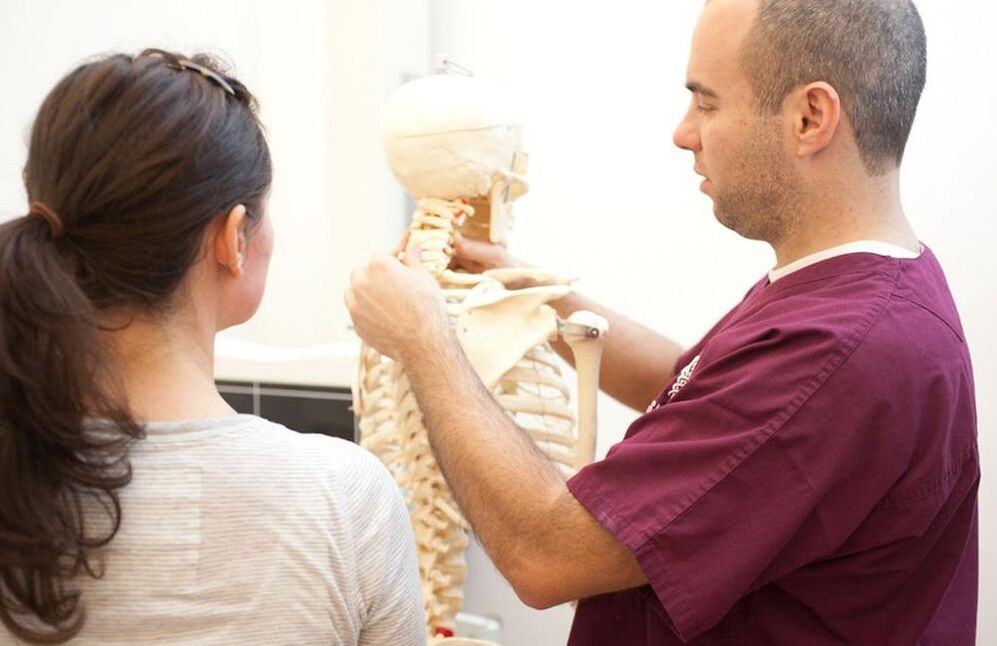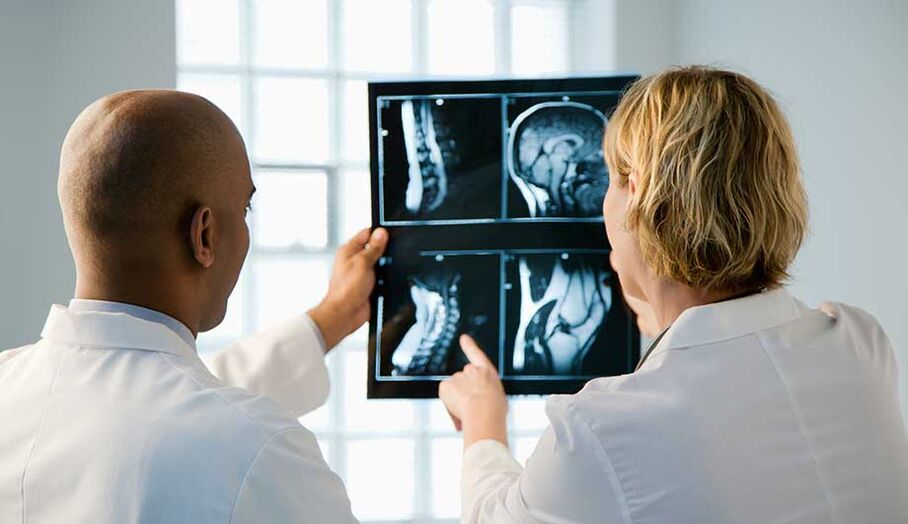
In the article, we will consider the symptoms and treatment of cervical spine osteochondrosis. What is this pathology? How does he manifest himself?
Osteochondrosis is practically the most common disease in the world. Many people after the age of 30 suffer from this pathology in various forms. There is also a tendency to rejuvenate the disease, which is to lower the age threshold. This may be due to the fact that there are now more and more people who are primarily engaged in work, where one spends most of the time sitting and leading an inactive lifestyle. By the way, such a disease is dangerous, and everyone must know what is cervical osteochondrosis, how it appears, how to treat it and how to identify its symptoms.

The main cause of the onset of the disease
One is designed in such a way that the vertical placement of the spinal space can lead to the fact that the vertebrae will be squeezed more over time, thus allowing the bones and cartilage tissue to gradually deteriorate and change shape.
The spine always starts with the cervical region, which has seven vertebrae. This is a very vulnerable part, as there is an increase in mobility in the area. Such diseases of the cervical spine are reflected, first of all, on the discs themselves, as they are weak points in the spine.
The frequency of degenerative disc disease of the cervicothorax region is aided by factors such as the small size of the vertebrae and the relative weakness of the neck muscles. In addition, poor blood supply to cartilage tissue affects the developing disease. What does all this mean?
Based on this, the development of the disease seems to be a long and complex process, in which it is very difficult to identify the cause. Although there is a link between lifestyle and cervixothoracic spine osteochondrosis, however, similar diseases are often found in trained people, especially athletes, as they have an increased load on the cervical spine. They lift various weights (barbells, weights), which leads to disc deformation. So everything needs measurement.

In the elderly and the elderly, as a rule, the decline of vertebral structure is an inevitable process, which in turn is associated with the aging of the body and the weakness of its defenses. But there are also types of pathology of osteochondrosis of the cervical spine, the symptoms of which appear due to internal or external negative factors. This includes:
- various back injuries;
- rachiocampsis;
- heavy weight;
- incorrect posture;
- hypodynamia;
- hard physical work;
- disturbed metabolic processes;
- hypothermia;
- overwork, stress;
- contagious disease;
- descent;
- congenital pathology or special features of body structure.
Stages of osteochondrosis of the cervical spine
Pathology has four stages. Sometimes it is quite difficult to determine the extent of what disease a patient has, according to general analysis, because often the degree of bone tissue decline may not coincide with the symptoms observed in the patient.
The first stage of the disease
At this stage, destructive action is already taking place in the spine. But the symptoms of cervical osteochondrosis are not yet so noticeable. People may not be aware of them or not associate these symptoms with spinal disease, they call it stress or superficial hard work.
The second stage of the disease
As already noted, the symptoms and treatment of cervical osteochondrosis are closely related.
At this stage, significant thinning of the disc occurs, and cracks appear on its surface. Symptoms of cervical osteochondrosis at this stage are observed in persistent pain, numbness of the face, weakness.

The third stage
How do the symptoms of cervical spine osteochondrosis manifest themselves at this stage? A herniated disc occurs, the cervical canal and muscles are affected. The person noticed dizziness and pain in the back of the head.
The fourth stage of the disease
With osteochondrosis of the cervical spine, osteophytes often occur - the proliferation of bone tissue that protects the vertebrae from stress, as a result of which it causes nerve pinching. This is characterized by stiffness of movement and damage to nearby joints.
Signs of cervical osteochondrosis
The main symptoms of osteochondrosis of the cervical spine are:
- Sharp pain in the shoulders and neck.
- Weakening of muscles.
- Increased sweating.
- Coordination is affected.
- Numbness in the hands.
- Dizziness.
- Hypertension.
- Decreased hearing and vision.
- Headache.
These frequent symptoms of osteochondrosis of the cervical spine can manifest themselves at all stages of the disease. In most cases, only a few signs from this list are visible, while others may be absent at all. Patients who see them for the first time are practically not diagnosed with cervical osteochondrosis. In this case, he can turn to different doctors - cardiologists, neuropathologists, therapists, surgeons. And a reliable diagnosis can eventually be identified with significant delay.
Pathological hazards
Not everyone knows the symptoms and treatment of cervical osteochondrosis.
The earliest symptoms of osteochondrosis can appear as early as 20 years, while the pain and discomfort are mild, so many people decide to wait, hoping the symptoms will pass, postpone a visit to the doctor and not start treatment. Symptoms in the early stages of osteochondrosis can go away on their own, but the disease will not go away from a person. If prevention and therapy are not carried out, osteochondrosis begins to develop further, and this can endanger human health.

What are the dangers of osteochondrosis of the cervical spine?
In the first stage, the symptoms are mild, so most people choose not to take the disease seriously. But if the patient does not start treatment early in development, this can lead to serious and dangerous complications. The consequence of a neglected level is a situation in which a person is unable to perform his or her functions. This is often accompanied by a wound on the adjacent part. Such abandoned osteochondrosis will lead to very dangerous consequences, followed by disability.
In addition, can grow:
- protrusion of the intervertebral disc;
- protrusion and intervertebral hernia;
- disk loss;
- lumbago or sciatica;
- rotation of the spinal canal.
In special cases, the diseases listed above are forced to undergo surgical intervention, and the consequence of further stage is disability.
The problems listed above are characteristic of osteochondrosis of the cervical spine.
Complications of the disease
The danger of this disease lies in the fact that the cervical area is connected to the ducts that supply the brain with blood. The consequences of cervical osteochondrosis are sleep disturbances, migraines, vision problems, dizziness. With further disease, the symptoms listed will become more pronounced. With cervical osteochondrosis, there are possible concomitant problems:

- high and low blood pressure and vascular dystonia;
- thyroid disease;
- vestibular disorders;
- hypertension or hypotension;
- stroke;
- epicondylitis;
- humeroscular periarthrosis.
Diagnostics of cervical spine pathology
The symptoms and treatment of cervical spine osteochondrosis are of interest to many people.
For a correct diagnosis, you must see a therapist. He will provide referrals to other specialists - neurologists, vertebrologists, orthopedists.
To diagnose this disease, the following types of studies are attached:
- CT scan;
- radiography;
- MRI;
- Doppler scanning.
X-rays revealed the presence of growths, vertebral displacement, salt deposits and osteophytes, disc cover. With the help of computed tomography, you can get an idea of a very large organ, in this case, about the cervical spine. This will make it possible to detail the stage of the pathological process, as well as the nature of nerve clamping, disc height, and osteophyte structure. Magnetic resonance imaging provides a more detailed picture of the structure of the spine. Ultrasound scans can help determine how the blood flow in the large cervical canal has changed, which is caused by the disease.

Treatment of this disease
Symptoms and treatment of cervical spine osteochondrosis are interrelated.
In order for a person to withstand disease, medicine has developed many methods. There are also therapies that you can use at home. But this procedure is a long recovery and impossible to do, especially in old age. But it should also be noted that it is possible to stop and slow down the pathological process in the spine at any stage of the disease.
In the first stage of the disease, methods of treating osteochondrosis of the cervical spine are mostly conservative. Several methods can be used for therapy:
- physiotherapy;
- medicines;
- massage;
- physiotherapy;
- special tools for repairing the spine.
If such a disease has entered an extreme stage, while the osteochondral structure of the spine is destroyed, then surgical intervention should be used to cure osteochondrosis of the neck.
Drugs for pathological therapy
Medications needed for the treatment of osteochondrosis of the cervical spine:
- analgesic;
- vitamins;
- chondroprotectors;
- anti-inflammatory drugs;
- antispasmodic.
When acute pain syndrome occurs, which is associated with osteochondrosis, the most important task is to remove it. In such cases, oral painkillers are taken, but if the effects are not visible, novocaine blockers can be used.
The symptoms and treatment of cervical spine osteochondrosis are often controversial for many people.
Antispasmodics are often taken. Muscle relaxation shows the greatest effectiveness in osteochondrosis. As a painkiller and anti-inflammatory, patients can use ointments that contain non-steroidal drugs.
If there are signs associated with disruption of blood supply to the brain and vertebral artery syndrome, it is necessary to use drugs that eliminate the unpleasant manifestations - drugs that lower blood pressure, and nootropic drugs.
The symptoms and treatment of cervical spine osteochondrosis are no longer a secret.

Physiotherapy training
Physiotherapy is the simplest and most accessible type of therapy and prevention of cervical osteochondrosis, and also quite effective. Physiotherapy can be done at home as well. With cervical osteochondrosis, class saturation does not play a large role, only its regularity is required. First of all, physical education is designed to strengthen the neck muscles, whose job is to compensate for the lack of spinal function and help support a weak spine. Treatment of osteochondrosis of the cervical spine should be done periodically.
Daily exercise is necessary to strengthen muscles. Such exercises are very simple, including turning and tilting the head in different directions, and quite complex, involving the hands to help the cervical muscles. It can be done at home and at work. For example, if you have to work all the time while sitting, then it is very useful to do a variety of exercises every hour sitting at a desk and monitor. But it should be done only when there is no exacerbating disease and there is no pain syndrome. Otherwise, this same exercise can only make matters worse.
It is also effective in the treatment of osteochondrosis of the cervical spine to strengthen the muscles of the shoulder girdle, for example, using light dumbbells in regular exercise. However, lifting weights such as kettlebells or barbells is contraindicated. Regular swimming can help, as it can relieve stress on the spine.
We examined the symptoms and treatment of cervical spine osteochondrosis.














































